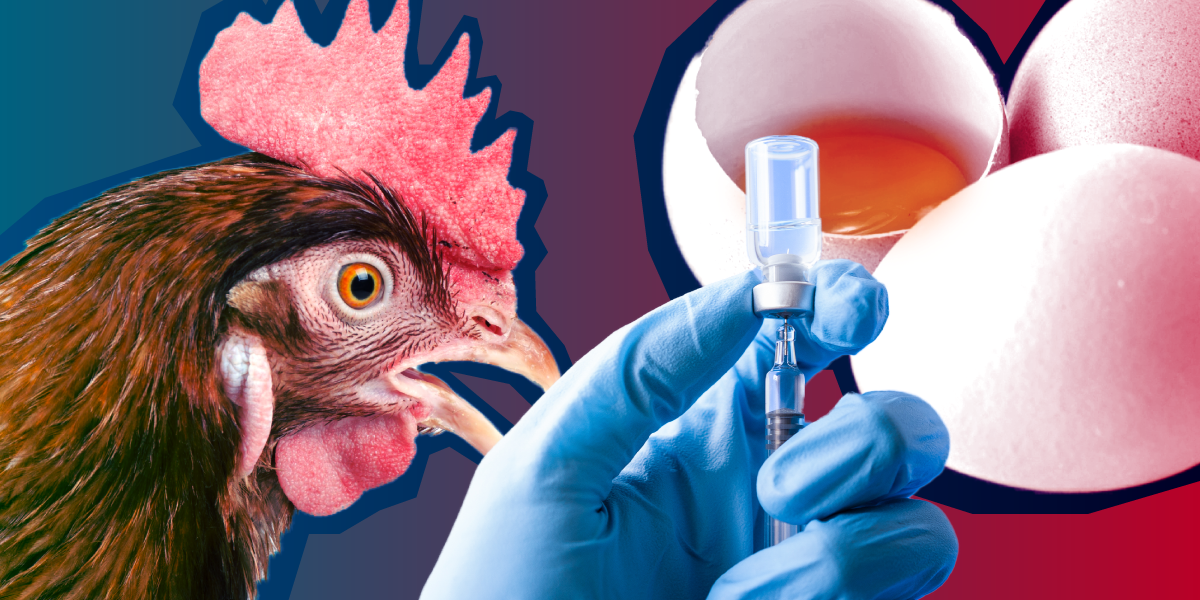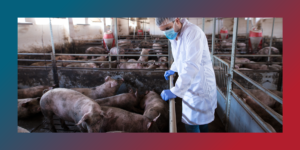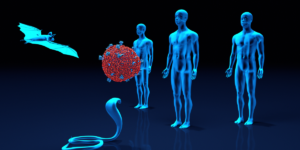As the world is embracing the virtues of non-animal derived meats (i.e., made from either plants or lab-grown, cultured protein), non-comestible items relying heavily on animal agriculture need to be rethought too. In our era, animal-derived products must not only keep human health in mind, they must reduce their impact on the environment.
Influenza vaccine is one such intensively animal-dependent product in need of upgrade.
For more than 80 years, the manufacture of seasonal flu shots has relied on the use of eggs—a staggering 1–3 billion of them each year. For reasons of national security, the locations of the massive chicken farms that produce the eggs are a carefully guarded secret.
The scope and scale of those industrial farms’ ecological impact are likewise immense. As well-documented contributors to global climate change, factory chicken farms have devastating environmental impact, including the destruction of natural habitat and degradation of local water quality. Startlingly, the carbon emissions of egg production equate to approximately 1 kg of CO2 for every four eggs produced. That has the carbon footprint of your annual flu shot, which requires two eggs to produce, weighing in at half a kilo in emissions—and that’s without accounting for the carbon output of actual manufacturing, or the worldwide distribution and delivery that must recur annually in order to maintain immunity.
Another harsh reality is that these eggs are not the type found on grocery store shelves. They are embryonated: fully fertilized, 10-day-old living embryos whose immature immune systems allow for a small dose of influenza virus, when injected into the egg, to replicate unfettered. Infected embryos are incubated in automated facilities the size of football fields and harvested a few days later. The influenza particles are then purified and inactivated for vaccine production.
And that is only the beginning of the environmental impact, sustainability, and animal welfare issues associated with dependence on chickens and eggs for flu vaccine manufacturing.
Opening the door to avian flu, viral drift and mutations
Ironically, industrially farmed chickens are themselves susceptible to influenza in the form of avian influenza or “bird flu,” and when an infection occurs the entire flock is culled. With avian influenza capable of making the jump into human populations, posing the threat of zoonotic infection with the potential to become a viral pandemic, flock destruction is not just a cost-saving measure but a necessity. Over the years, though, outbreaks of avian influenza and the resulting destruction of massive chicken populations have occurred numerous times (most recently in 2015), leading to worldwide shortages of seasonal influenza vaccines for humans.
The use of embryonated eggs, moreover, introduces the potential for “drift” or viral mutations that undermine the efficacy of the vaccine in humans. When introduced into an embryonated chicken egg, the influenza virus undergoes replication, with the potential to simultaneously mutate, just as it does within human hosts. This leads to viral adaptations that grow well in chicken eggs but may have mutated away from the actual strains circulating in humans. With the length of time that elapses between the WHO’s yearly release of predicted viral strains and the delivery of seasonal vaccines at your local pharmacy (which is, on average, six months), vaccine efficacy in humans is significantly reduced: the cumulative weaknesses in the chicken-and-egg method leave the efficacy of the seasonal flu vaccine at 30%–60% at best.
The need to rethink the system, to develop new science and new technology, has grown increasingly obvious and has led to recent FDA approval of two alternatives to the chicken-and-egg manufacturing system.
Two new approaches—neither meets the criteria for true sustainability or pandemic preparedness
One of these methods (Flucelvax by Seqirus) uses cultured mammalian cells that mimic the role of the egg. While this method bypasses the need for chicken farms and egg incubation facilities, intact viral growth is still required and mutation is still possible. Chicken allergens are avoided in the final vaccine product, but, because whole virus is produced, other controversial formulation ingredients are required. Whole viral vaccines still require excipients (chemicals such as mercury salts, formaldehyde, latex, and aluminum salts) to increase immunogenicity and to stabilize their viral content for effective delivery.
A second approach (Flublok by Protein Sciences–Sanofi) uses insect cells engineered to make a single, recombinant influenza protein. This creates what is called a “subunit” vaccine, that is, a vaccine containing no whole or infectious viral particles but only small, non-infective components of the virus. It is analogous to the spike protein being used in the manufacture of the COVID-19 vaccines, and it represents a significant leap forward on the production side.
However, both approaches still require revaccination of the population year after year. In other words, every year the entire production and distribution process must be repeated—just as it has been for the past 80 years—with continued low efficacy rates. The environmental impact of manufacturing and distribution remains unchanged. Moreover, the prospect of achieving herd immunity never emerges and the possibility of a pandemic influenza persists. As we have learned from the COVID-19 crisis, if protective measures are not in place in advance of a bad bug rearing its head, by the time it does appear it will be too late.
A flu vaccine to achieve sustainable production, herd immunity and pandemic preparedness
A truly sustainable vaccine would not only require the elimination of the full range of costs and risks associated with chickens and eggs, it would also be durable and effective at rates currently much greater than 30%–60%. Compounding the maximal 60% vaccine efficacy rate, only 30% of the US population gets vaccinated in any given year. These two factors are sufficient to eliminate any chance of achieving herd immunity on their own, much less combined. EnGen Bio’s science aims to produce an immune response that would last a person or animal’s lifetime and be effective against all type A flu strains. Instead of an annual shot, a lifetime total of one or two doses could be enough to protect an individual from all type A flu strains past, present and future, and all flu pandemics (which notably, are exclusively type A). This novel strategy to combat the virus, combined with a recombinant subunit approach, opens up the possibility of the flu vaccine becoming a standard health-and-wellness shot no different from the measles/mumps/rubella (MMR) vaccine or possibly the tetanus vaccine, which requires a booster shot every 10 years.
Given today’s efficiencies of recombinant protein production, a single 50,000 liter fermenter could, in the span of one to two months, produce enough vaccine for the entire US population far in advance of both seasonal and pandemic needs. If that single facility were run year-round, it could produce enough doses for global use. This would allow enough people to get vaccinated that herd immunity could finally take hold throughout the world population.
What problems would a recombinantly manufactured universal influenza vaccine strategy mitigate?
- Dependency on vast populations of animals and animal products and on problematic, environmentally damaging methods with significant carbon footprints.
- Vaccine shortages due to chicken flocks being infected with flu.
- The need for strain prediction and the likelihood of ‘drift’ of the virus away from the strains supplied by the WHO; low efficacy rates of vaccines.
- Infections in humans and animals with the worst strains of flu; flu pandemics.
- The need for annual manufacturing of the Type A flu vaccines and their associated carbon footprints.
- ‘Scrambling’ to ramp up when a flu pandemic emerges (thanks to Covid19, we’ve learned that preparedness is the only sustainable solution).
The time has come for the world—people, animals, the environment—to get a break from the old-school approach to the flu. Science is ready to make it happen.



